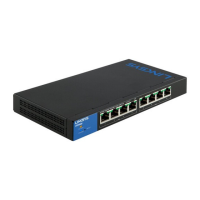11
Table of Contents
Linksys
System Time
System time can be set manually by the user dynamically from an SNTP server.
If an SNTP server is chosen, the manual time settings are overwritten when
communications with the server are established.
As part of the boot process, the device always configures the time, time zone,
and DST. These parameters are obtained from SNTP, values set manually, or, if
all else fails, from the factory defaults.
Time
The following methods are available for setting the system time on the device:
• Manual—You must manually set the time.
• SNTP—Time can be received from SNTP time servers. SNTP ensures
accurate network time synchronization of the device up to the millisecond
by using an SNTP server for the clock source. When specifying an SNTP
server, if choosing to identify it by host name, three suggestions are given
in the GUI:
• time-a.timefreq.bldrdoc.gov
• time-b.timefreq.bldrdoc.gov
• time-c.timefreq.bldrdoc.gov
NOTE:
SNTP is the recommended method for time setting.
Time Zone and Daylight Savings Time (DST)
The Time Zone and DST can be set on the device in the following ways:
• Dynamic configuration of the device through a DHCP server, where:
• Dynamic DST, when enabled and available, always takes precedence over
the manual configuration of DST.
• If the server supplying the source parameters fails, or dynamic
configuration is disabled by the user, the manual settings are used.
• Dynamic configuration of the time zone and DST continues after the IP
address lease time has expired.
• Manual configuration of the time zone and DST becomes the Operational
time zone and DST, only if the dynamic configuration is disabled or fails.
NOTE:
The DHCP server must supply DHCP option 100 in order for dynamic time
zone configuration to take place.
SNTP Modes
The device can receive the system time from an SNTP server in one of the
following ways:
• Client Broadcast Reception (passive mode)—SNTP servers broadcast the
time, and the device listens to these broadcasts. When the device is in this
mode, there is no need to define a Unicast SNTP server.
• Client Broadcast Transmission (active mode)—The device, as an SNTP
client, periodically requests SNTP time updates. This mode works in either
of the following ways:
• SNTP Anycast Client Mode—The device broadcasts time request
packets to all SNTP servers in the subnet, and waits for a response.
• Unicast SNTP Server Mode—The device sends Unicast queries to a list
of manually-configured SNTP servers, and waits for a response.
The device supports having all of the above modes active at the same time
and selects the best system time received from an SNTP server, according to
an algorithm based on the closest stratum (distance from the reference clock).
System Time
Use the System Time page to select the system time source. If the source is
manual, you can enter the time here.
CAUTION:
If the system time is set manually and the device is rebooted, the manual
time settings must be reentered.
To define system time, do the following:
STEP 1 Click Configuration > System Management > Time > System Time.
The current time on the device is displayed. This shows the DHCP time zone or
the acronym for the user-defined time zone if these were defined.
STEP 2 Enter these parameters:

